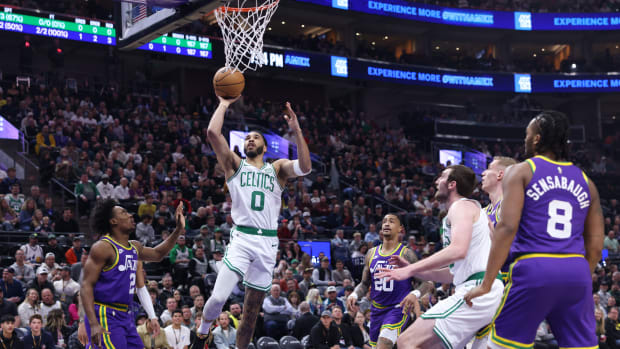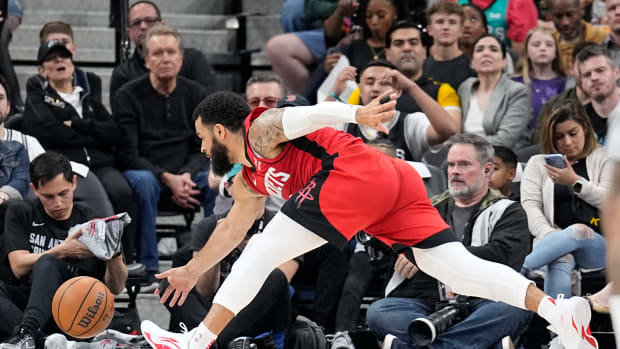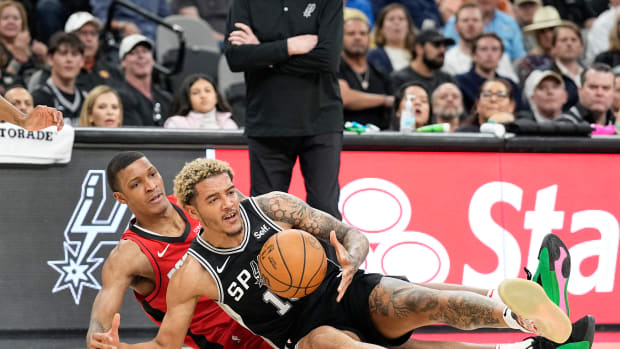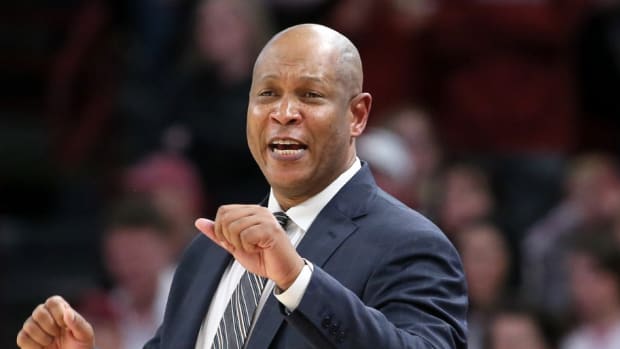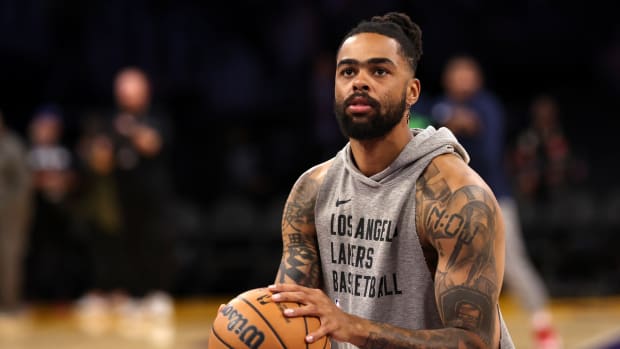Just over a year ago, center Tristan Thompson, then with the Cavaliers, spoke with reporters about the team's newest acquisition, Andre Drummond, and how the two-time All-Star was underappreciated.
“Dre’s situation in Detroit, we know what it is—[the Pistons] are going through a situation, and unfortunately no longer wanted his services. But one team’s trash is another team’s treasure,” he said, after the Cavaliers poached Drummond from the Pistons for little more than a 2023 second-round pick.
Now, though, Cleveland has put Drummond out on the curb for pickup, too. The club announced it would hold Drummond out of action until it can find a new landing spot for him. But in scouring the NBA in hopes of getting a second-round pick in return for the 27-year-old big man, the Cavs have found no takers. Short of an 11th-hour trade deadline move, Cleveland will buy out Drummond’s deal in the coming days.
It’s a strange predicament facing Drummond, who is simultaneously the best rebounder in the universe but also seemingly of little value in today’s league—both from a trade standpoint and a depth-chart one, given that two of the NBA’s weakest teams have opted to move on from him in the past year and change.
In a way, Drummond’s dilemma begs a larger question: Does rebounding truly matter in today’s game?
There's no need to beat around the bush when analyzing Drummond’s 2020–21 campaign.
While he’s had a handful of bright spots—a pair of massive steals in an overtime win against Detroit, and a game-sealing assist late versus Memphis—it’s been a rough year for Drummond, all things considered.
He ranks as the NBA’s worst finisher at the rim and is shooting a career-worst 47.4% from the field, a pair of tough realities when you’re a soon-to-be free agent that’s earning almost $29 million for the season.
Yet Drummond’s elite skill—rebounding—hasn’t diminished one bit. He averaged 15 rebounds per game in 2017–18, 2018–19 and 2019–20, giving him as many 15-board-per-game campaigns as the rest of the league combined over the past 20 seasons. And before the Cavaliers sidelined him this year, Drummond’s 26.1% rebound percentage and 37% defensive-rebound percentage were both league-best marks, too.
The center’s odd career limbo comes as the Pelicans and Magic lead the NBA in rebound rate and defensive rebound rate, respectively, yet find themselves in the distant rearview mirror of the league’s playoff picture. So what does it say when literally no one’s willing to give up even a second-round pick for the world’s best rebounder, and the league’s best rebounding teams are ones with poor records?
More than anything, it means priorities have shifted elsewhere throughout the association.
Where offensive players once crashed the offensive glass with reckless abandon, now they merely backpedal as shots go up, hoping to stave off an opponent’s transition opportunity. Where the game was once played with the spacing of a small shoebox, now offenses fire away at will from the arc, leaving them further from the rim and out of ideal rebounding position. “It used to be that the lane was crowded, where there’d be a free-for-all to grab a board,” says Hall of Famer Dave Cowens, one of the best rebounders in league history. “Now, you look up and the only guys you’re contending for a rebound with are your teammates.”
In a way, Drummond’s role as a dominant defensive rebounder is like that of a prolific video-store renter, who’s always managed to nab the hit movie from Blockbuster as soon as it came out. It was an impressive feat before. But now, with Netflix—and hardly anyone else in the store—it’s not as meaningful a skill.
With most teams no longer emphasizing offensive boards, just 22.1% of attempts have been retrieved by the offense during the 2020–21 season—the lowest rate in NBA history, and an unrecognizable figure juxtaposed against the 1980s and ’90s, when one of out every of three misses went back to the offense.
It’s no secret that the proliferation of the three-point shot—which generally creates much longer rebound opportunities—has altered the game more than anything. At .696, the statistical correlation between three-point percentage and winning percentage in the NBA (with 0 showing no correlation, and 1 indicating direct correlation) has never been higher than it is now, according to data from Stats Perform.
Because of that shift, teams are all but forced to put more weight on players, centers or otherwise, who can capably defend the arc. Even a 7-footer like Roy Hibbert, who excelled at using verticality to protect the rim, found himself out of a job at age 30, in part because of his relative immobility. Just like there were no shots for the paint-tethered Hibbert to block if someone shot a triple, there are no rebounds for players like Drummond to grab if a sharpshooter hits a wide-open three.
“If you look back at my era [in the 1980s and ’90s],” Sixers coach Doc Rivers says, “it was the GOAT era of bigs. Someone like Andre Drummond? He would have fit right in with that generation of play.”
This era, however, is showing to be altogether different.
Much like there's been a sudden market correction with NFL running backs, the NBA seems to be scaling all the way back in terms of how it sees the value of the rebounding specialist.
Before Drummond, Thompson got a big five-year, $82 million payday with Cleveland—one that topped out at more than $18 million for last season alone. (This past offseason, on the open market as a 29-year-old, he fetched $9.5 million per year.) Similarly, Trail Blazers rebound machine Enes Kanter made $20 million as recently as three seasons ago, in the midst of a max deal, but now, at 28, he earns $5 million per year.
No one is bold enough to say rebounding doesn’t matter in today’s game. Of course, it does. All it takes is one missed rebound—with Miami’s Chris Bosh storming in to corral a must-have board and then finding Ray Allen in the corner—to show how boards can shift the course of basketball history. But the truth is, modern-day teams that hit countless triples have shown they can get away with not being able to rebound.
The Warriors currently rank 29th—right in between the Timberwolves and the Rockets, who own the worst records in the NBA—in rebound percentage, grabbing just 47.4% of all missed shots. If the season ended today, Golden State, in ninth place out West, would finish as one of the worst rebounding clubs in history to reach the postseason.
Along those same lines, in 2017 and 2018, the last two years LeBron James led the Cavs to the Finals, Cleveland ranked 18th and 24th, respectively, in rebound rate. They excelled from the perimeter instead.
With those sorts of teams having four or even all five players spaced out to the arc at times, they’ll see it as more worthwhile to focus on defense. “Statistically, it shows that if you get back every single time, you’re gonna save more points than you’d score by going to the glass [after offensive boards],” Rivers says.
And even when clubs do vie for offensive rebounds, because of the longer shots they’re taking, the misfires are likelier to bounce toward the perimeter than in previous eras. It means rebounders need more range. “Maybe 10 or 12 years ago, you’d only see a few types of guys going for [offensive boards]. Now, you see perimeter guys with that freedom, says Steve Clifford, who coaches the Magic. “With all the long rebounds now, there’s a larger area defensively you have to track in order to finish possessions.”
Which means quickness matters as much as, if not more than, traditional jockeying strength at times.
Clifford points out that a handful of teams last year—the Suns, Pacers, Grizzlies and Bulls—ranked near the top of the NBA in both putback efficiency and in transition defense, which may be the next type of players teams will seek. Which athletes have enough cat-like quickness and basketball instincts to jump into the fray from the three-point line and come up with the ball while still getting back to help defend?
They probably aren’t ones whose games resemble Drummond’s. In a fast-paced game of musical chairs, with teams shape-shifting their rosters around an unprecedented spike in three-point shooting, the overhaul has at least temporarily left the generation’s best rebounder without a seat.
“It’s just a matter of how people see the game, see Andre and what he can add to their team,” says Stan Van Gundy, who coaches the Pelicans—the NBA leaders in rebounding—and who worked with Drummond in Detroit. “At this stage, there aren’t many centers everybody’s gonna demand. Jokić or Embiid? Certainly. But not many where all 30 teams say, ‘Oh, we want that guy.’ It’s more about fit now.”

































